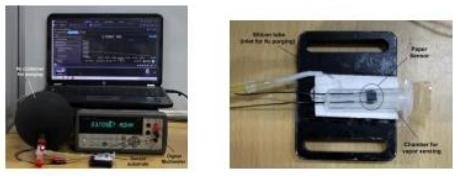The present invention relates to a polymer coated paper-based sensors for volatile organic compounds comprising a chamber housing a sensor and a source of volatile vapor, a sensor consisting of a paper and a conducting polymer combination, a silicon tube inserted into the centrifuge tube to act as an inlet for N2 purging, a digital multimeter or any other recording or data logging device connected to said sensors, a Principal Component Analysis (PCA) or similar algorithm to differentiate various volatile organic compounds present in breath. The conducting polymer is deposited on the paper and chamber is made from a micro centrifuge tube with two holes drilled at the bottom for insertion of the sensor. The present invention also provides a process for preparing sensor.
The conventional methods for detecting volatile organic compounds (VOCs) in human breath, such as gas chromatography (GC) or mass spectrometry (MS), are expensive, bulky, and require highly trained personnel. These methods are not suitable for field deployment or real-time, non-invasive diagnostics. Therefore, there is a need for a cost-effective, portable, and easy-to-use sensor capable of detecting VOCs, especially acetone, ethanol, and methanol, which are associated with medical conditions like diabetes.
- Polymer-Coated Paper Sensor: The sensor uses a paper substrate coated with conducting polymers like PPy (polypyrrole) and PAni (polyaniline), which is sensitive to VOCs.
- Non-Invasive Detection: The sensor can detect VOCs in human breath without the need for invasive procedures like blood tests.
- Reusability: The sensor is designed to be reusable, reducing overall costs, and ensuring sustainable usage.
- Low Cost: Made from inexpensive materials like filter paper and conducting polymers, the cost per sensor is extremely low (~INR 2-5).
- Portable and Easy to Use: The sensor is compact, does not require bulky instruments, and can be used in field conditions for real-time monitoring.
- Customization for Various VOCs: The sensor is adaptable for detecting different VOCs like acetone, ethanol, and methanol, making it useful for diagnosing various medical conditions.
The sensor consists of a Whatman filter paper coated with a conducting polymer (PPy or PAni). The paper is cut into small pieces (6 mm x 5 mm) and exposed to a solution of monomer and oxidizing agent to create a conducting polymer layer. The sensor is housed in a small chamber with an inlet for N2 purging. A digital multimeter or similar data-logging device measures the resistance change as the sensor interacts with different VOCs. The sensor is tested for VOCs like acetone, ethanol, and methanol, and can differentiate them using Principal Component Analysis (PCA).
The technology is at hypothesis testing, demonstration in lab stage.
4
The sensor provides a non-invasive method for monitoring medical conditions like diabetes, improving public health by eliminating painful blood pricks. Its low cost makes it accessible, especially in low-resource settings, enabling early disease detection and potentially saving lives. Made from biodegradable materials, it supports sustainability in the medical device industry and empowers patients to manage their health with frequent, painless, breath-based diagnostics.
- Healthcare and Medical Devices: For non-invasive diagnostics, particularly for conditions like diabetes, asthma, and other diseases linked to VOCs in breath
- Consumer Electronics: Portable diagnostic tools for home use to monitor VOCs in breath and make healthcare more accessible
- Environmental Monitoring: Useful for detecting VOCs in the air to monitor pollution or hazardous substances
- Agriculture: Detection of VOCs emitted by crops or pests to assess plant health or pest infestations
- Biotechnology: Applications in metabolic research, where VOCs are indicative of metabolic changes in living organisms
Geography of IP
Type of IP
202021025009
471124

